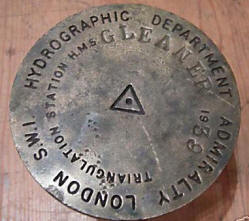Sloops were to be designed primarily
for minesweeping and simply fitted for their survey role.
The fit for surveying was similar to
the Convoy Sloops. No armament was to be fitted, though the Survey
Minesweeping Sloops were fitted for but not with the standard Halcyon
armament of 2 x 4-inch guns and small arms. A large chartroom was built at
the after end of the forecastle deck, and the bridge was enlarged to make
it more commodious for sextant angle fixing. A large derrick was fitted on
the forecastle for handling survey beacons (floating marks like very large
dan buoys).
The two types could be distinguished
at a glance by their masting. FRANKLIN and SCOTT
the surveying ships, stepped their foremasts on the forecastle, rigging
the beaconing derrick directly to the mast.
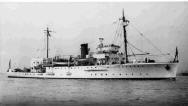 FRANKLIN 1947
FRANKLIN 1947
 SCOTT
SCOTT
GLEANER
and JASON, the minesweeper conversions,
though built in the surveying configuration, stepped their foremasts in
the standard Halcyon position aft of the
bridge, and carried a stump for the derrick in the W gun position. All, in
their pre-war surveying configuration, carried pole mainmasts stepped just
forward of the chartroom.
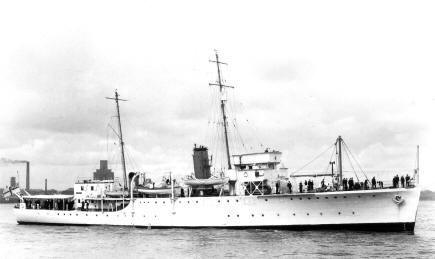 GLEANER 1937
GLEANER 1937
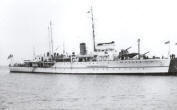 JASON 1938
JASON 1938
The four
ships were built as follows:
|
Ship
|
Built
by |
Laid
down |
Launched
|
Completed
|
|
GLEANER
|
Gray,
Hartlepool
|
17.06.1936
|
10.06.1937
|
30.03.1938
|
|
JASON
|
Ailsa,
Troon |
12.12.1936
|
6.10.1937 |
21.04.1938
|
|
FRANKLIN
|
Ailsa,
Troon |
17.12.1936
|
22.12.1937 |
14.06.1938
|
|
SCOTT
|
Caledon
,
Dundee
|
30.08.1937
|
23.08.1938 |
14.10.1938
|
GLEANER,
JASON
and
FRANKLIN
all started surveying in home waters in the summer and autumn of 1938, to
be joined by SCOTT in 1939. FRANKLIN
was the only one to serve overseas, working on the Labrador coast
in the summer of 1939.
JASON and
GLEANER quickly reverted to general service on the outbreak of war.
They were armed, and became to all intents and purposes standard Halcyons,
and like their sisters were employed as much on escort duties as on
minesweeping. FRANKLIN and SCOTT
each received a single 3-inch AA gun in a bandstand for'ard of the
foremast on the forecastle and a varied fit of small arms. They kept the
big chartroorn aft, but lost their mainmasts to topweight compensation.
They were employed on a variety of tasks, mainly in support of minelaying
and mine clearance, but also surveying new fleet anchorages and bases in
the United Kingdom and northern waters. One little-known exploit was that
when BISMARCK broke out SCOTT was send ahead of HOOD and PRINCE
OF WALES to check on the position of the edge of the pack ice off
Greenland. Fortunately for her she did not encounter the German squadron.
After
the war FRANKLIN and SCOTT
were quickly disarmed and restored to full surveying status. A minor
distinction which identifies them post-war is that while FRANKLIN'S
mainmast was restored to its pre-war position for'ard of the chartroom,
SCOTT'S
was stepped on the chartroom roof. For a period in 1946-47, while
operating in the Thames with HDMLs attached to her, FRANKLIN
had a heavy rubbing strake fitted on her quarters just above the
waterline. Though SCOTT also operated with
MLs at this time she was not, apparently, fitted with this.
Though both JASON
and GLEANER survived the war, neither
returned to surveying. Instead, SEAGULL and SHARPSHOOTER
were given to Hydrographer in 1945 and converted to replace them.
They introduced the third variant in surveying
Halcyon masting, since though they, like their predecessors, were
fitted with a beaconing derrick and stump on the forecastle and maintained
their foremast aft of the bridge, they did not have their mainmasts
restored, so a Halcyon in surveying white and
buff without a mainmast must be one of these later two.
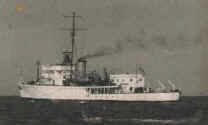 SHARPSHOOTER 1950 Chartroom added postwar
SHARPSHOOTER 1950 Chartroom added postwar
SEAGULL
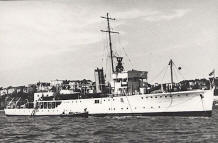
SHARPSHOOTER
went out to the Far East in 1946 to relieve the verminous converted yacht WHITE
BEAR, and surveyed round the Malay
Peninsula and Borneo for two years before the arrival of the first of the
converted BAYS - HMS DAMPIER. Apart from this,
all four spent the remainder of their days in home waters.
SEAGULL was
the first to go. Having spent the 1950 season with a reduced crew mainly
in Torbay, she paid off that autumn, and was scrapped by Demmelweek and
Redding in Plymouth in 1956. FRANKLIN was
paid off at the end of the 1952 season and went to the breakers at Dunston,
also in 1956.
 HMS
SHACKLETON
HMS
SHACKLETON
SHARPSHOOTER
was renamed SHACKLETON in June 1953 to bring
her into line with all the other surveying ships named after famous
explorers and surveyors. At this time she was fitted with a topmast to her
derrick stump to carry a forward steaming light, needed after the
exemption of warships from the Collision Regulations for lights was
written out in their 1952 revision. She soldiered on until 1962, when she
ended her surveying season and entered Devonport with the Hydrographer
embarked on 9th November to pay off for disposal. She was broken up at Troon
at the end of 1965. SCOTT lasted two more
years in service, paying off in November 1964 but preceding her sister to
the breakers in Troon, arriving in June 1966.
